Top 10 examples and anti-examples of developer-audience interaction: Part One
Recently, the relationship between the gaming community and developers (both major publishers and independent studios) has become increasingly dynamic and sharp. The game community began to recognize itself as a force and began to put pressure on the studio, sometimes even aggressive.
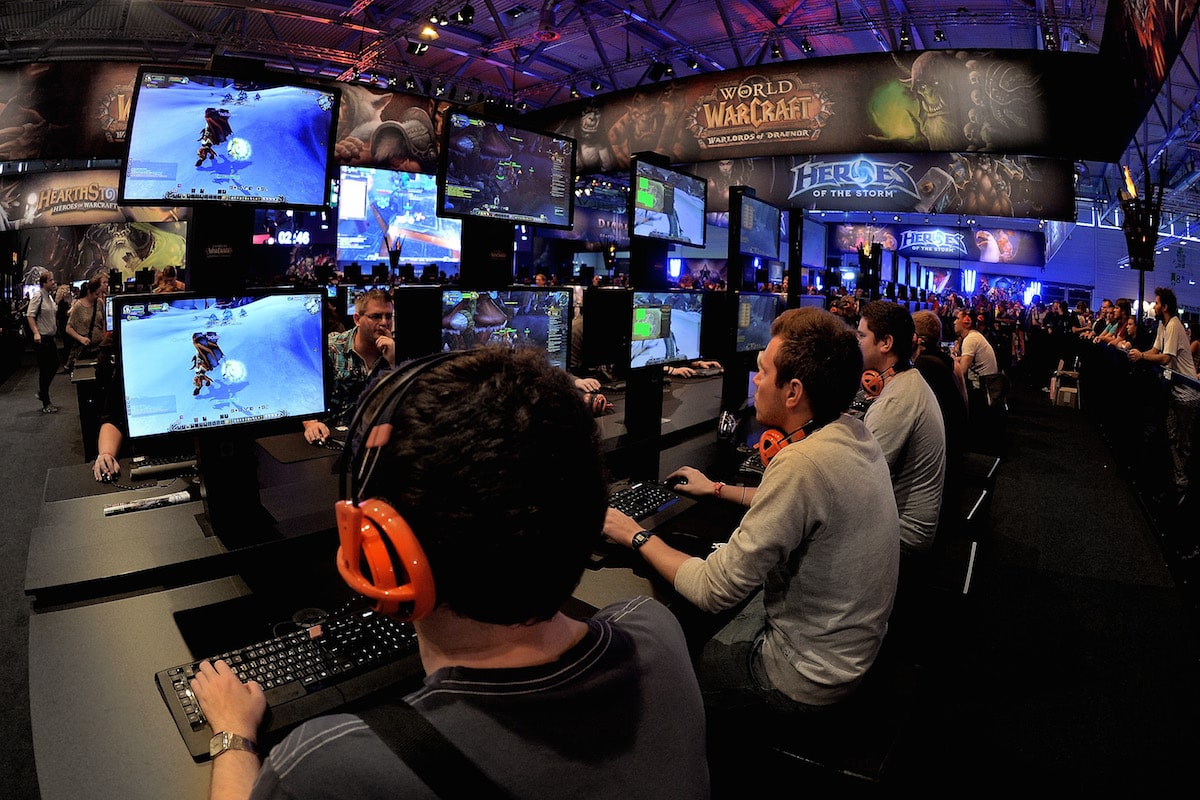
The whole of 2017, Steam was in a fever from the waves of negative feedback, and the press wrote every week about how the publisher or developer changed their decisions under pressure from the audience. At the same time, the gaming community also has favorite studios, which are given a huge credit of trust - they are almost ready to be carried. These studios communicate with the audience on an equal footing, and the audience supports them, both moral and material.
')
What do the former do and what the latter don't do? What is the difference between these studios? How to work with such a troubled structure as a gaming community? In this article, which will consist of two parts, I tried to analyze the current situation in the gaming community, taking as an example ten companies, some of which work well with the audience, and some ... well, let's say, not so well. The ranking of the list is very conditional, but one can say for sure that the guys in the top positions are doing everything correctly (as far as relations with the community are concerned), and those who are from the bottom are doing something wrong. At the same time, I will not talk about the quality of games or other merits and features of these companies - it will be about interaction with the audience.
I must say at once that the above analysis is naturally subjective. However, at the time of writing, I relied on real data: responses of active players (some of which I requested directly from them, but more on that later), information about sales, etc. Also, I don’t know all the game studios in the world, so if you know a good example that I didn’t have, write about it in the comments and maybe I will add an article if I agree with your assessment. The rating of the author is also completely subjective and made just to make it easier to navigate the list.
And a few more reservations. Initially, I wanted to write about independent gaming studios, in which the developer himself builds a policy of communicating with users. There are many similar examples, but the problem is this: it often happens that the studio was independent for many years, but then passed under the publisher’s wing and became an internal studio. In this case, the policy of communication and all interaction with the community already take over the publisher's SMM structures. I nevertheless included several such studios, since the publisher does not always exert pressure, which forces the studio to radically change its approach. And, of course, I will not mention major publishers like Ubisoft or Electronic Arts, since the interaction of such conglomerates with the community is the topic of a separate article. If you want, you can immediately mentally put them on the last places in the list.
Now a little about the process of collecting information: when writing a review, I spoke with various representatives of the Russian-speaking community (at the end of the article I will list everyone who helped me and give excellent examples of fan conglomeration), so the feedback was very fresh. Initially, one article was planned, but the material turned out to be very diverse and the final text grew so that it was necessary to divide it into two parts.
So, let's begin.

Name: Amplitude Studio
Foundation Date: 2011
Famous Games: Endless Space, Endless Legend Series
Authors rating: 5/5
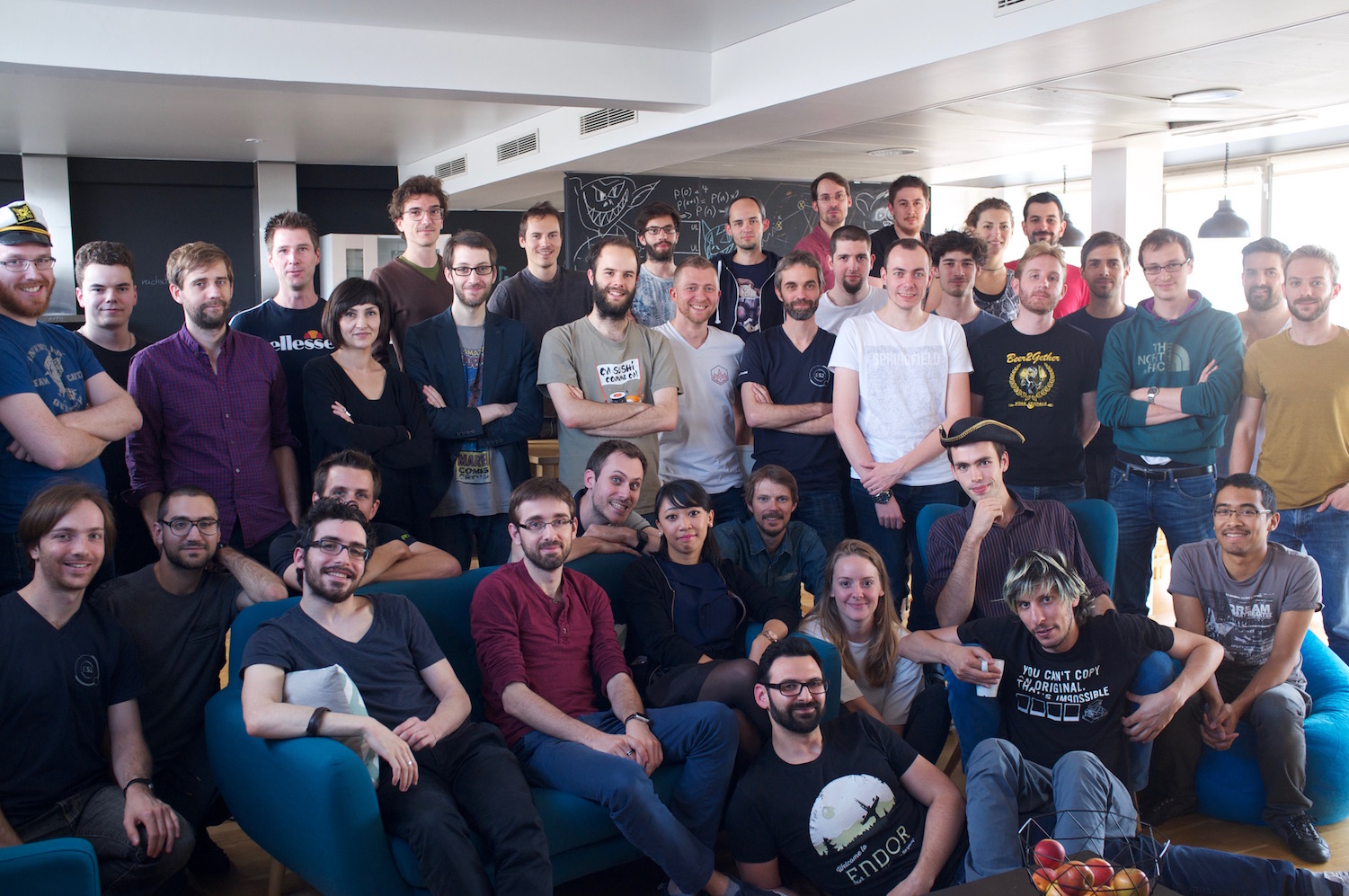
French studio Amplitude Studio was founded in 2011 by two people from Ubisoft, Mathieu Girard and Romain de Vober. The studio immediately set itself the goal of making the best 4X strategies on the market and largely succeeded in this area.

Last game studio - Endless Space 2
From the very beginning, Amplitude has created a unique system in which the gaming community itself participates in the creation of the game. The name of this system is Games2Gather. With the help of Games2Gather, people can offer their ideas to developers, participate in the voting for the best features and influence the order of development of game elements.
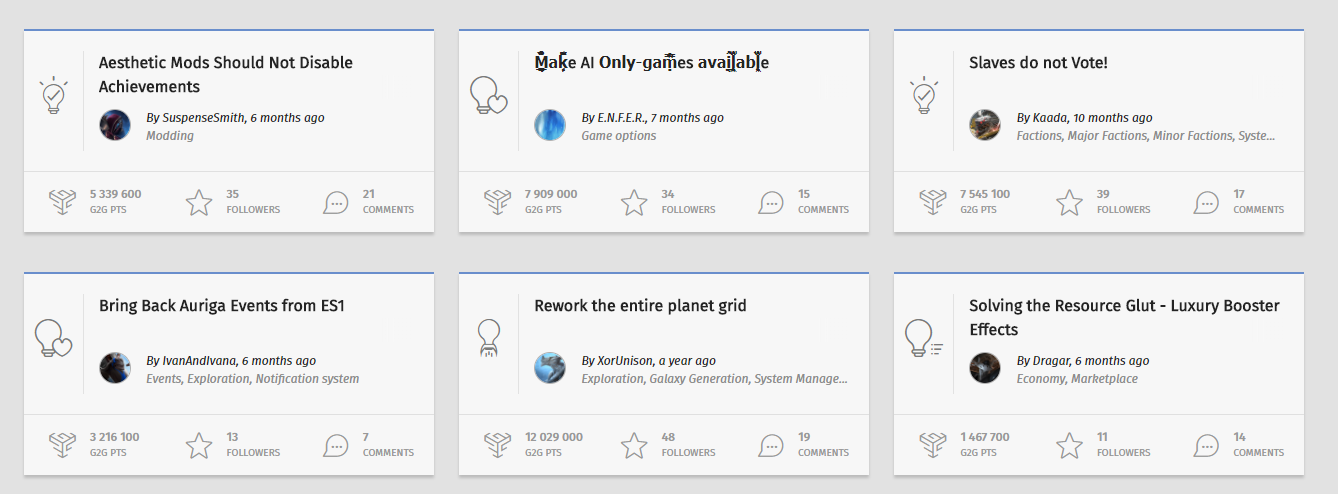
An example of a dashboard of ideas in Games2Gether
In fact, before Amplitude there were studios that actively attracted the community (as an example, many studios could work with the mod community), but they are the first to bring this interaction to such a systemic and effective level.
Why was this done in Amplitude? The answer lies in the genre in which the studio works. 4-strategy is a very complex and highly specialized genre with a very sensitive community that can react rapidly to changes in the canonical laws of gameplay. Therefore, Amplitude even before the release of Endless Space connected fans to the development and to the release of the working version received a ready-made community on Steam, good first sales and distribution in social networks.
At the moment, the developer has released four games, and the community has a hand in each of them. At the same time, Amplitude constantly pampers its fans: free add-ons, global events with bonuses - such gifts are received by players from their favorite company. For all this, Amplitude Studios gets to the top of our conditional top.

Title: Gearbox Software
Founded: 1999
Famous Games: Borderlands Series, Brothers In Arms Series
Authors rating: 4/5

Gearbox Software was founded in January 1999 by five members of the Rebel Boat Rocker studio that closed shortly before: Randy Pichford, Stephen Bachl, Landon Montgomery, Brian Martel and Rob Heyronimus. The studio immediately showed a good level, first as a developer of global mods for Half-life (Opposing Force, Blue Shift), and then as the creator of the Brothers In Arms series.
In the case of Gearbox Software, we are confronted with the influence of the identity of the individual on the formation of attitudes towards the company as a whole. Referring to the influence of the personality, it is impossible not to recall the masters of the gaming industry, for example, Will Wright or Peter Molyneux (a separate article can be devoted to this person).

Randy and the Borderlands - Claptrap mascot
But back to gearbox. Randy Pichford is a very talented person, but sometimes he allows himself strange things in communicating with the audience. He is famous for two things: promises and swearing on Twitter. A surplus of promises is really a problem of Gearbox: promises of mountains of new content, promises to take into account past mistakes, promises of soon announcements of new games ... And not all of this comes true. Therefore, people treat Randy's stories with caution, but at the same time continue to love Gearbox (especially Borderlands-community). The studio had the most serious problems after the release of Aliens: Colonial Marines. The game was very much awaited, as a successor of the ideas of the film “Aliens. In fact, the community got a medium and very buggy shooter. The game has collected mixed reviews from players and the press, for the most part, negative.
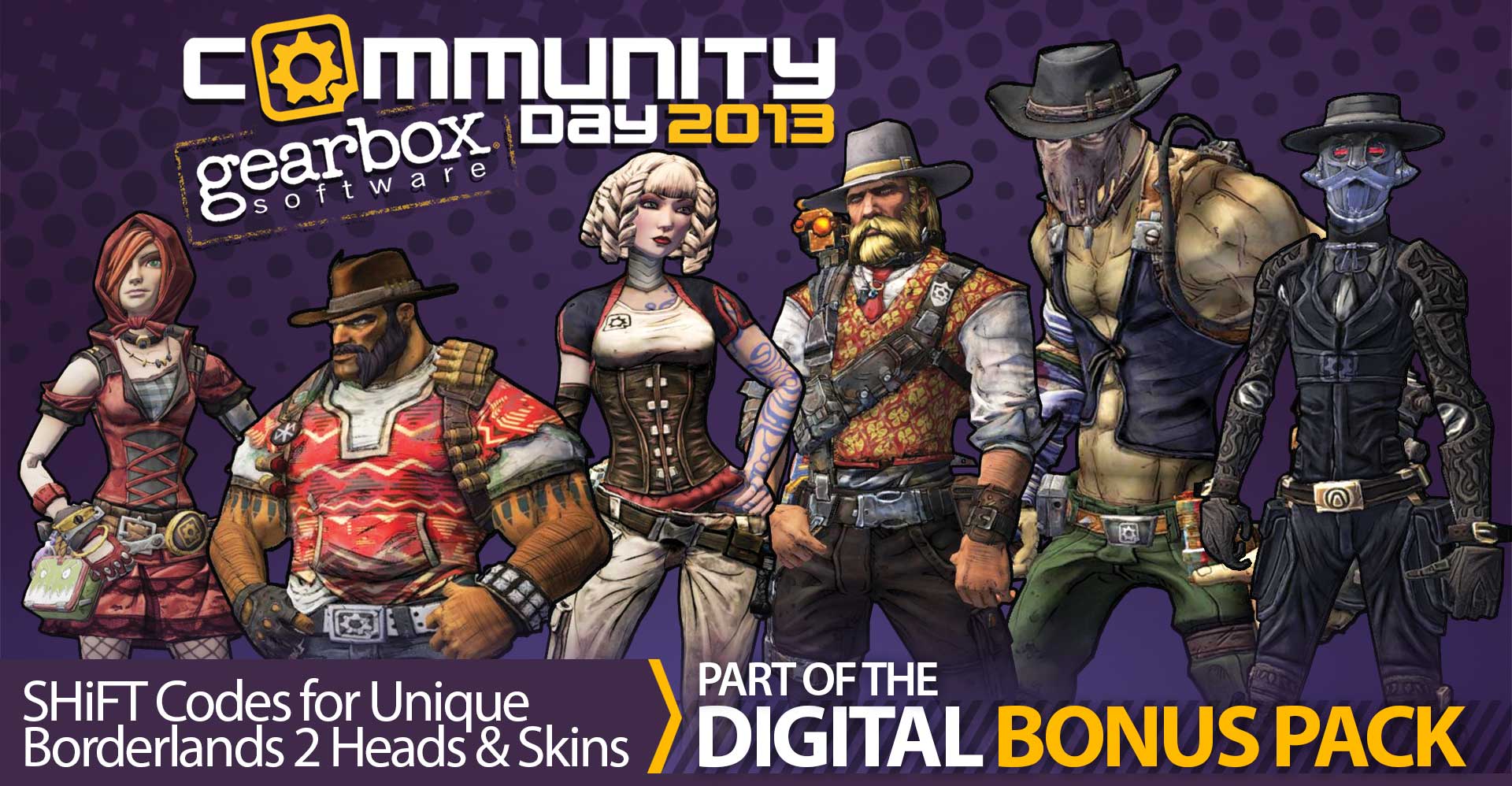
Community Day 2013 and new SHIFT codes
Well, what good does Gearbox do when communicating with the audience? First of all, they are supported by the fact that the community is always up to date with the life of the company. Yes, we have to scoop up information from Randy's presentations and Twitter - Gearbox does not keep a separate news blog, but still people know what their favorite studio does. Another Gearbox often takes part in various conferences and similar events. In addition, the studio supports its community and in every way encourages fan art, cosplay and other works based on their games.
Finally, Gearbox has created an interesting system of SHIFT codes, which are published on Twitter (and not only). With the SHIFT code, people can unlock character skins, unique weapons and other content in the Borderlands games. The players liked the system very much - they were given a real hunt for the codes.
In addition to all of the above, the studio experimented with global events in the Borderlands a couple of times: all the players participated in them, and the reward was ranked according to the overall effort. I personally observed the activity of the community at this time and I can say that it was very fun.
The relationship between developers and fans is rather warm, although this heat is sometimes limited by publisher policies. On the official forum of the studio, the most active members of the community receive the title Gearbox Commuinity Badass and various bonuses. The developers themselves (as well as artists, screenwriters, etc.) drop in on Reddit and Discord channels and periodically keep up with fans in a twitter thread.
As a result, Gearbox has a large community, in many aspects a supporting studio. But with the justification of the expectations of the audience at the studio sometimes trouble. At the moment, the whole community is looking forward to the announcement of Borderlands.

Name: Team 17 Digital Limited
Founded: 1990
Famous Games: Worms Series
Authors rating: 4/5
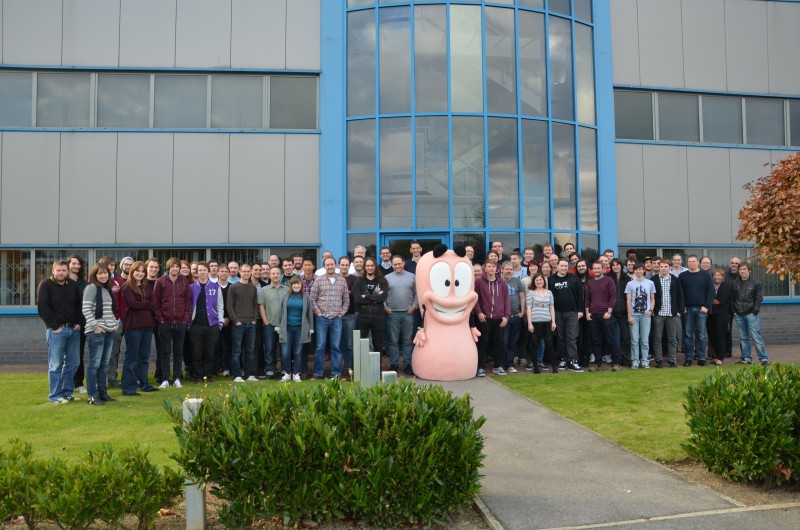
Team17 is a good example of a “beloved, warm and lamp developer” who moved away from his hardcore audience. The studios are more than 25 years old, and it still has not transferred “more than 100 employees” abroad and has not been absorbed by any publisher. Moreover, she herself began to help indie developers and publish small indie projects.
Team17 is famous, of course, for its Worms series. It was this game that rallied the players into the community around the studio. Worms have always had a lot of content from the audience: here you can include maps, modifications and much more. Even before the advent of broadband Internet, the community had already created championships and completely new game modes, which gradually developed and began to live their lives. Players in Worms probably know the abbreviations BnG, BnA and others. The community plays in these modes, maybe even more than in the original games.

A series of Worms can not even show, it is known to everyone who has ever sat at the computer
Team17, for its part, was just a good and open source developer ... until relatively recently. The problems began when it became clear that Team17 chose self-copying as the main tactic. Yes, this approach attracted a new, young audience and allowed to produce Worms on a variety of platforms, but in terms of mechanics, the series did not advance. The hardcore part of the audience, the so-called “core”, still played Worms Armageddon or the Worms World Party. For this part of the audience, the new games in the Worms series are simply trimmed versions of the classic titles. Yes, Worms Reloaded (also known as console Worms 2: Armageddon) had nice graphics, good style and was an excellent reissue of the 2D series, but the types of weapons in Reload are three times less than in classic Worms. Hence, an abbreviated set of game situations and the simplification of the gameplay itself, for the variety of which we love the series.
At the moment, the studio is deaf to the requests of the old part of the community, and even during beta tests it doesn’t really listen to them. Yes, the new parts continue to give money and inject new blood into the community, but how long will the series last on a similar approach? They say that in the new Worms MWD developers have already promised a long game support and strong work with the community.

For 25 years, it seems not too much, but the community requires more unique content

Name: Nadeo
Foundation Date: 2000
Famous Games: Trackmania Series
Authors rating: 3/5
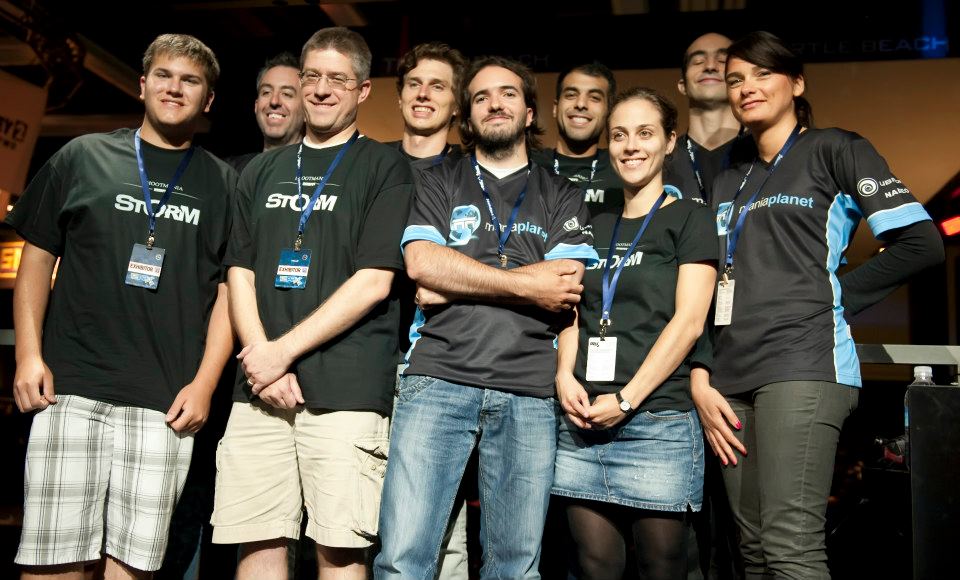
Of all our list of game studios, Nadeo is probably the least known, but her case is very interesting. Studios is already 17 years old, and she is the creator of the magnificent Trackmania series of games. Like many example games from this article, Trackmania immediately gathered a community around itself. If who does not know, Trackmania is a series of arcade races with crazy tracks that consist of tunnels, dead loops and twisted roads. In the very first version of Trackmania, there was already a very simple track editor, which many game fans immediately mastered. Then sites began to appear where players exchanged tracks. Later modelers and texture makers who made models of cars and skins for them were connected. This is how the Trackmania community was created.
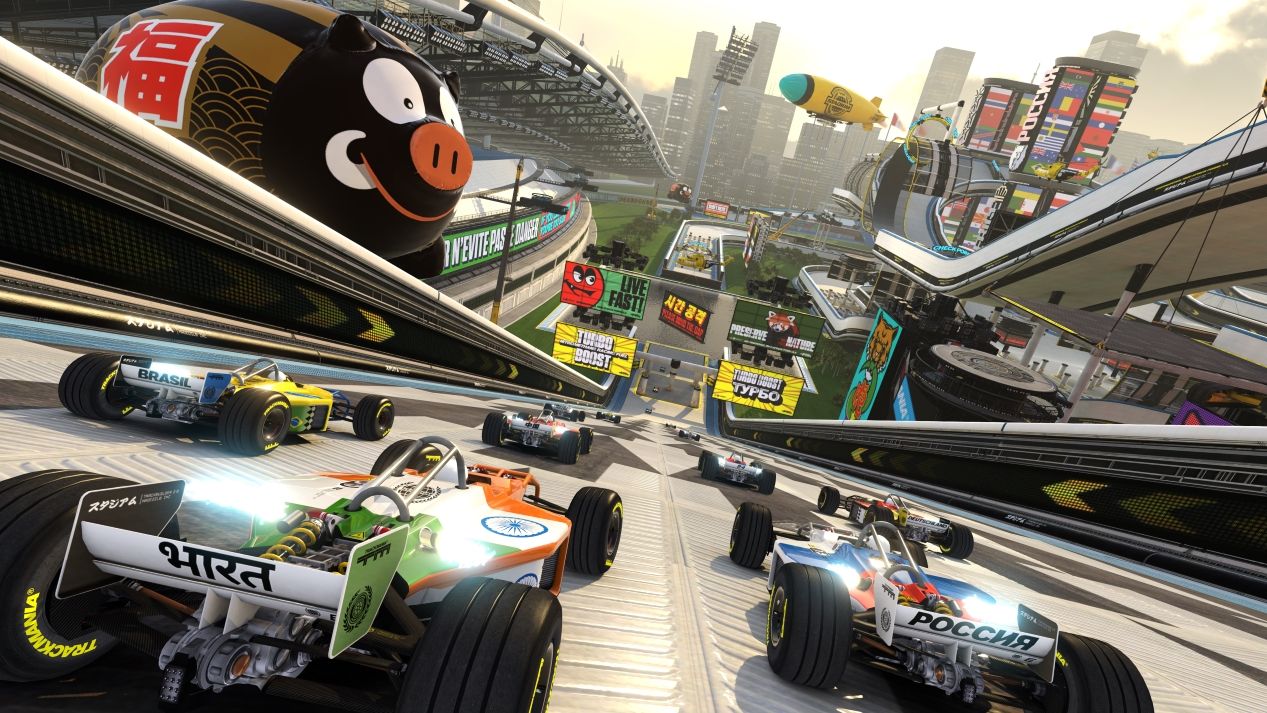
Actually, Trackmania itself!
And now a little more about the Trackmania itself.
At the time of the release of TrackMania Nations and TrackMania United in 2006, the game began to steadily move to the online mode and participate in competitions at the Electronic Sports World Convention (ESWC). After this success was reinforced by the additions TrackMania United and TrackMania Nations Forever. It was 2008, which can be considered the peak in the development of the community and its cohesion.
The series needed development, a qualitative breakthrough. This breakthrough was to be Trackmania 2 and its innovative social platform Maniaplanet. It was assumed that it would unite the studio community into a single network: in one system the fans of races (Trackmania), shooters (Shootmania) and RPG (Questmania) were supposed to connect.
What do we have at the moment? Trackmania lives, but the number of users has plummeted. Shootmania swamps with empty servers. About the unannounced Questmania all have long been forgotten. Why did this happen? Let's see.
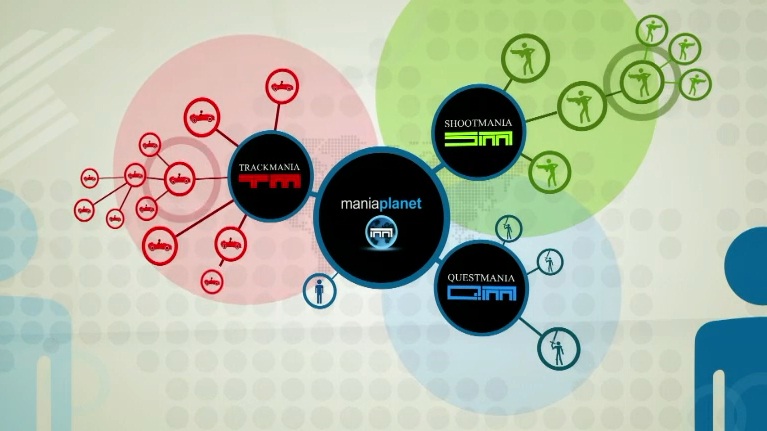
Initially, everything looked interesting ...
When such a complex project as Maniaplanet was announced, delays in releases immediately began. As a result, Trackmania 2 came out later than planned, and was divided into several parts. Note: there were 7 types of environments in Trackmania United (even if they represented a compilation from the previous parts), and in Trackmania 2 there were already only 3. And even then, each environment was sold as a separate game, for the full price.
After the community saw that the game, after three years of development, was not only almost unchanged, but came out “piece by piece”, it quickly began to disintegrate. The intervals between the release of individual "games" (and in fact, just the environments) in the Trackmania 2 series were for two whole years (2011 - TrackMania 2: Canyon, 2013 - TrackMania 2: Stadium and TrackMania 2: Valley). Yes, these were great games, but why so long? Why not all at once? Answer: Maniaplanet.
As planned by the authors, through Maniaplanet, you can play races, go to the common portal and start playing shooter. There are also loaded titles - sets and modifications from the community. It turns out something like Steam inside Steam. It looks, in general, interesting. You get to the main page and through separate windows you can open different games without even restarting them on Steam. The idea is large-scale and innovative, but ... too large-scale for a small French studio. Imagine: you decided, let's say, to play races, go into the game, and there you are greeted by this!
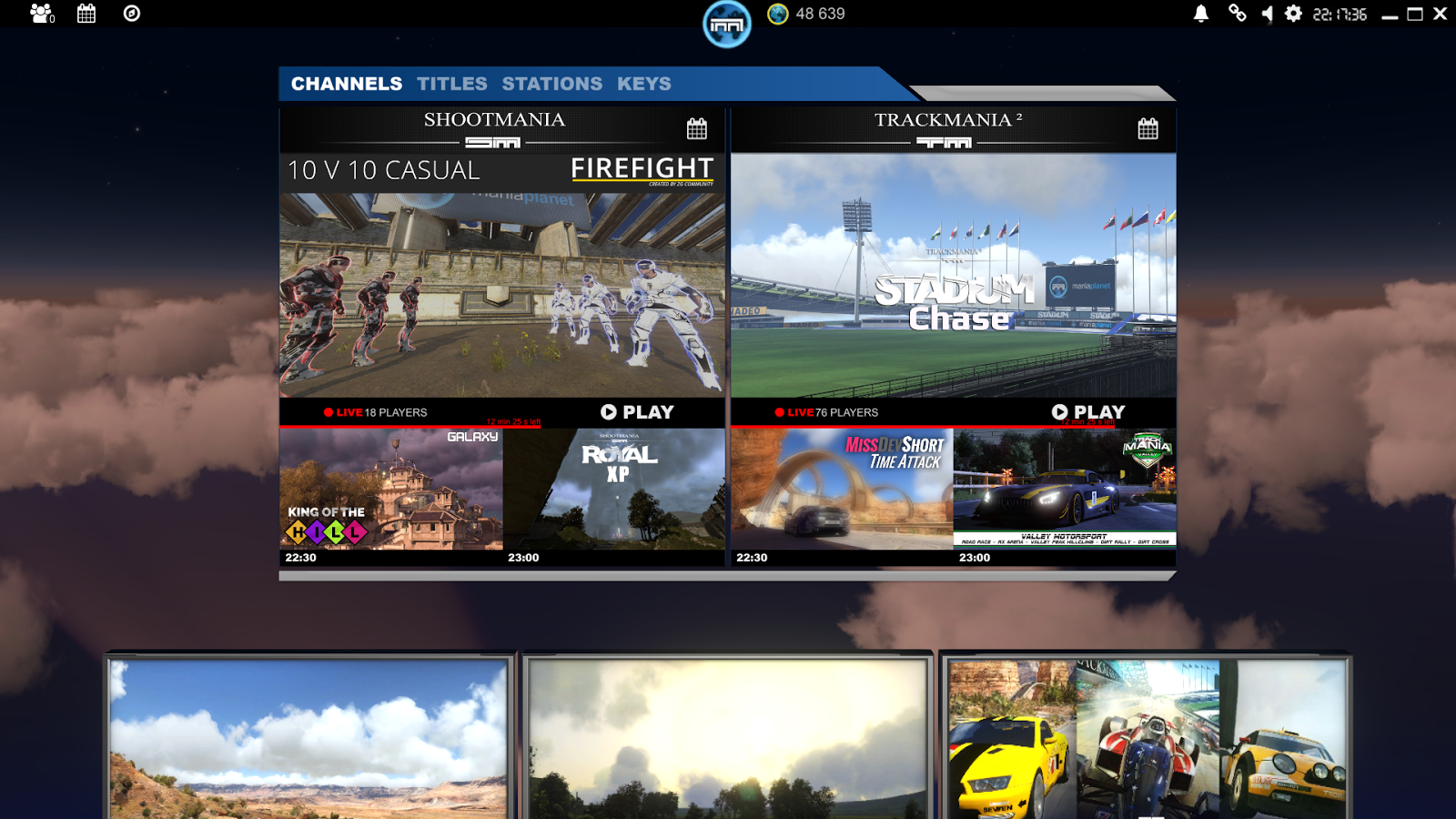
As a result, the excessive inter-integration of games scared off new players, and then gradually the old ones began to leave as well, who are still arranging competitions at the United. Shootmania shooter tritely failed the test of time and lost users. Trackmania, too, lost people when initially a huge audience. What should be done in this situation? Give up ideas? Make normal clients for games? Listen to the community? No, they said in Nadeo, we continue to work on the old concept.
In 2009, the company acquired Ubisoft, which so far practically does not interfere with the work of the studio. This is the moment when it would be time to intervene. The Maniaplanet system pulls the studio back, and the director of Florent Castelnérac (known as Hylis), who firmly defends his position, supports this stagnation, banning people in the forum and authoritatively bending their line. Only recently the studio released Maniaplanet v4, where there are a lot of new features, but even more minuses. Features are aimed at community development, but it melts before our eyes. It turns out the classic shoemaker without shoes.
In 2013, Trackmania Turbo was released, in the creation of which the hand of Ubisoft is felt. The game is not tied to Maniaplanet, it works on consoles and contains 4 types of maps at once. Yes, Turbo was very trimmed in terms of customization and community tools, but still it is a step towards the players.
If you compare Nadeo, for example, with Team17, you can see a very big difference: Team17 is constantly doing something new and thus accumulates a new audience. Nadeo makes one release in three years, and each time it attracts less and less people. If Nadeo does not change its course, then Trackmania will be one of those games whose lives are smoldering in small groups of the former community.

Name: Bethesda Game Studios
Founded: 2001
Famous Games: The Elder Scrolls Series, Fallout Series
Authors rating: 3/5
I recall that earlier the company was one with the parent company Bethesda Softworks, and with the release of The Elder Scrolls III: Morrowind in 2002, it had its own name and logo. In connection with this structure, it is difficult to talk about who exactly is interacting with the community, but, most likely, people from Bethesda Softworks who make key decisions are responsible for this. So here I will talk about the cumulative actions of the studio and the publisher, since in this situation they, in fact, represent one whole.

Bethesda's situation with the audience is interesting because the core of the community is rather old, because it began to take shape after the release of The Elder Scrolls III: Morrowind in 2002.
Notice that almost all the games in this article form their community through user-generated content. So the Elder Scrolls series has gathered around itself modders, programmers and ordinary players who have been making content for games in the series for 15 years now. And if you look at the work of Bethesda Game Studios in the Elder Scrolls series, then there are no questions about it. The audience accepts new games and continues to work on additional content. But there were some not entirely successful decisions that led to a strong resonance within the community.
Bethesda is famous for its love of paid add-ons. For example, in 2006, an attempt was made to make a paid addition to regular horse armor at TES IV: Oblivion. Armor was priced at $ 2.5. Despite the very low cost, rather harsh accusations were heard against Bethesda and Microsoft, in which they were reminded of the high cost of the Xbox 360 version of the product (compared to the PC), and many other sins. After all, for PC lovers this supplement is distributed for free! Marketers of the company were confident that the problem was not the price itself, but the price-quality ratio. As a result, Bethesda began experimenting with the prices of additional content, which still causes the indignation of the community.
If you look at the latest events, we again return to the topic of paid modifications. At E3 2017, Bethesda announced the Creation Club, a service that should turn the idea of paid mods. The service touched Fallout and The Elder Scrolls V: Skyrim - Special Edition. The intentions of Bethesda seem to be good: the creators of mods will receive their income, and the game will be updated with higher-quality modifications, thanks to the increased motivation of modders, but the community did not like this initiative. Rating in Steam at Fallout 4 and TES: Skyrim collapsed against the background of general discontent. The comments were simple: “Creation Club!”. Even those who once stood for paid modding, expecting to get decent content at reasonable prices, were shocked that paid mods turned out to be nothing more than a set of a pair of guns, skins and several armor models. In this case, the prices for content were set inadequately high. In general, more than 10 years have passed since the history of horse armor, and the studio, and personally Todd Howard, stubbornly continues to be guided in their actions primarily by greed ...

Typical situation in September 2017
Another problem of the studio is the old community, which passed to them "in inheritance" along with the Fallout brand. Hardcore players insistently ask for the repetition of old successes and at the same time want the deviations from the classics to be moderate. New players, on the contrary, require modern features in the old mechanics.
Such a confrontation greatly complicates the work of the studio, which is trying to sit on two chairs. As a result, most fans of classic Fallout curse developers for Fallout 4, but at the same time it remains the most profitable game of the studio, and it already has a younger community.
Conclusion
As you can see, there are many ways to interact with the community and not all of them lead to good results. Studios have to keep a balance between profits and the loyalty of players, or use very powerful mechanisms that can maintain both indicators at a high level. Recently, the gaming community, realizing its conciliarity to influence the course of events, periodically puts pressure on the studio. Someone is influenced, someone is not.
All this brings us to the idea that each case of working with the community needs to be analyzed separately: analyze the behavior of the studios and avoid the mistakes that we have already made.
As I have already said, initially the article described the work of ten studios, but the material was very voluminous, so it was decided to divide it into two parts. In the second part you are waiting for: Valve, id Software, Blizzard Entertainment, CD Project RED and Paradox Interactive.
If you have any comments or suggestions on the topic of the article, please leave them in the comments, and we will discuss everything. In addition, if you yourself are an active participant in gaming communities, we will be interested to hear about your personal experience with developers - perhaps it will be useful for the next article.
Thank you all for your attention! See you in the next part!
Special thanks to the communities and people who helped me in writing this article:

The whole of 2017, Steam was in a fever from the waves of negative feedback, and the press wrote every week about how the publisher or developer changed their decisions under pressure from the audience. At the same time, the gaming community also has favorite studios, which are given a huge credit of trust - they are almost ready to be carried. These studios communicate with the audience on an equal footing, and the audience supports them, both moral and material.
')
What do the former do and what the latter don't do? What is the difference between these studios? How to work with such a troubled structure as a gaming community? In this article, which will consist of two parts, I tried to analyze the current situation in the gaming community, taking as an example ten companies, some of which work well with the audience, and some ... well, let's say, not so well. The ranking of the list is very conditional, but one can say for sure that the guys in the top positions are doing everything correctly (as far as relations with the community are concerned), and those who are from the bottom are doing something wrong. At the same time, I will not talk about the quality of games or other merits and features of these companies - it will be about interaction with the audience.
I must say at once that the above analysis is naturally subjective. However, at the time of writing, I relied on real data: responses of active players (some of which I requested directly from them, but more on that later), information about sales, etc. Also, I don’t know all the game studios in the world, so if you know a good example that I didn’t have, write about it in the comments and maybe I will add an article if I agree with your assessment. The rating of the author is also completely subjective and made just to make it easier to navigate the list.
And a few more reservations. Initially, I wanted to write about independent gaming studios, in which the developer himself builds a policy of communicating with users. There are many similar examples, but the problem is this: it often happens that the studio was independent for many years, but then passed under the publisher’s wing and became an internal studio. In this case, the policy of communication and all interaction with the community already take over the publisher's SMM structures. I nevertheless included several such studios, since the publisher does not always exert pressure, which forces the studio to radically change its approach. And, of course, I will not mention major publishers like Ubisoft or Electronic Arts, since the interaction of such conglomerates with the community is the topic of a separate article. If you want, you can immediately mentally put them on the last places in the list.
Now a little about the process of collecting information: when writing a review, I spoke with various representatives of the Russian-speaking community (at the end of the article I will list everyone who helped me and give excellent examples of fan conglomeration), so the feedback was very fresh. Initially, one article was planned, but the material turned out to be very diverse and the final text grew so that it was necessary to divide it into two parts.
So, let's begin.

Name: Amplitude Studio
Foundation Date: 2011
Famous Games: Endless Space, Endless Legend Series
Authors rating: 5/5

French studio Amplitude Studio was founded in 2011 by two people from Ubisoft, Mathieu Girard and Romain de Vober. The studio immediately set itself the goal of making the best 4X strategies on the market and largely succeeded in this area.

Last game studio - Endless Space 2
From the very beginning, Amplitude has created a unique system in which the gaming community itself participates in the creation of the game. The name of this system is Games2Gather. With the help of Games2Gather, people can offer their ideas to developers, participate in the voting for the best features and influence the order of development of game elements.

An example of a dashboard of ideas in Games2Gether
In fact, before Amplitude there were studios that actively attracted the community (as an example, many studios could work with the mod community), but they are the first to bring this interaction to such a systemic and effective level.
Why was this done in Amplitude? The answer lies in the genre in which the studio works. 4-strategy is a very complex and highly specialized genre with a very sensitive community that can react rapidly to changes in the canonical laws of gameplay. Therefore, Amplitude even before the release of Endless Space connected fans to the development and to the release of the working version received a ready-made community on Steam, good first sales and distribution in social networks.
At the moment, the developer has released four games, and the community has a hand in each of them. At the same time, Amplitude constantly pampers its fans: free add-ons, global events with bonuses - such gifts are received by players from their favorite company. For all this, Amplitude Studios gets to the top of our conditional top.

Title: Gearbox Software
Founded: 1999
Famous Games: Borderlands Series, Brothers In Arms Series
Authors rating: 4/5

Gearbox Software was founded in January 1999 by five members of the Rebel Boat Rocker studio that closed shortly before: Randy Pichford, Stephen Bachl, Landon Montgomery, Brian Martel and Rob Heyronimus. The studio immediately showed a good level, first as a developer of global mods for Half-life (Opposing Force, Blue Shift), and then as the creator of the Brothers In Arms series.
In the case of Gearbox Software, we are confronted with the influence of the identity of the individual on the formation of attitudes towards the company as a whole. Referring to the influence of the personality, it is impossible not to recall the masters of the gaming industry, for example, Will Wright or Peter Molyneux (a separate article can be devoted to this person).

Randy and the Borderlands - Claptrap mascot
But back to gearbox. Randy Pichford is a very talented person, but sometimes he allows himself strange things in communicating with the audience. He is famous for two things: promises and swearing on Twitter. A surplus of promises is really a problem of Gearbox: promises of mountains of new content, promises to take into account past mistakes, promises of soon announcements of new games ... And not all of this comes true. Therefore, people treat Randy's stories with caution, but at the same time continue to love Gearbox (especially Borderlands-community). The studio had the most serious problems after the release of Aliens: Colonial Marines. The game was very much awaited, as a successor of the ideas of the film “Aliens. In fact, the community got a medium and very buggy shooter. The game has collected mixed reviews from players and the press, for the most part, negative.

Community Day 2013 and new SHIFT codes
Well, what good does Gearbox do when communicating with the audience? First of all, they are supported by the fact that the community is always up to date with the life of the company. Yes, we have to scoop up information from Randy's presentations and Twitter - Gearbox does not keep a separate news blog, but still people know what their favorite studio does. Another Gearbox often takes part in various conferences and similar events. In addition, the studio supports its community and in every way encourages fan art, cosplay and other works based on their games.
Finally, Gearbox has created an interesting system of SHIFT codes, which are published on Twitter (and not only). With the SHIFT code, people can unlock character skins, unique weapons and other content in the Borderlands games. The players liked the system very much - they were given a real hunt for the codes.
In addition to all of the above, the studio experimented with global events in the Borderlands a couple of times: all the players participated in them, and the reward was ranked according to the overall effort. I personally observed the activity of the community at this time and I can say that it was very fun.
The relationship between developers and fans is rather warm, although this heat is sometimes limited by publisher policies. On the official forum of the studio, the most active members of the community receive the title Gearbox Commuinity Badass and various bonuses. The developers themselves (as well as artists, screenwriters, etc.) drop in on Reddit and Discord channels and periodically keep up with fans in a twitter thread.
As a result, Gearbox has a large community, in many aspects a supporting studio. But with the justification of the expectations of the audience at the studio sometimes trouble. At the moment, the whole community is looking forward to the announcement of Borderlands.

Name: Team 17 Digital Limited
Founded: 1990
Famous Games: Worms Series
Authors rating: 4/5

Team17 is a good example of a “beloved, warm and lamp developer” who moved away from his hardcore audience. The studios are more than 25 years old, and it still has not transferred “more than 100 employees” abroad and has not been absorbed by any publisher. Moreover, she herself began to help indie developers and publish small indie projects.
Team17 is famous, of course, for its Worms series. It was this game that rallied the players into the community around the studio. Worms have always had a lot of content from the audience: here you can include maps, modifications and much more. Even before the advent of broadband Internet, the community had already created championships and completely new game modes, which gradually developed and began to live their lives. Players in Worms probably know the abbreviations BnG, BnA and others. The community plays in these modes, maybe even more than in the original games.

A series of Worms can not even show, it is known to everyone who has ever sat at the computer
Team17, for its part, was just a good and open source developer ... until relatively recently. The problems began when it became clear that Team17 chose self-copying as the main tactic. Yes, this approach attracted a new, young audience and allowed to produce Worms on a variety of platforms, but in terms of mechanics, the series did not advance. The hardcore part of the audience, the so-called “core”, still played Worms Armageddon or the Worms World Party. For this part of the audience, the new games in the Worms series are simply trimmed versions of the classic titles. Yes, Worms Reloaded (also known as console Worms 2: Armageddon) had nice graphics, good style and was an excellent reissue of the 2D series, but the types of weapons in Reload are three times less than in classic Worms. Hence, an abbreviated set of game situations and the simplification of the gameplay itself, for the variety of which we love the series.
At the moment, the studio is deaf to the requests of the old part of the community, and even during beta tests it doesn’t really listen to them. Yes, the new parts continue to give money and inject new blood into the community, but how long will the series last on a similar approach? They say that in the new Worms MWD developers have already promised a long game support and strong work with the community.

For 25 years, it seems not too much, but the community requires more unique content

Name: Nadeo
Foundation Date: 2000
Famous Games: Trackmania Series
Authors rating: 3/5

Of all our list of game studios, Nadeo is probably the least known, but her case is very interesting. Studios is already 17 years old, and she is the creator of the magnificent Trackmania series of games. Like many example games from this article, Trackmania immediately gathered a community around itself. If who does not know, Trackmania is a series of arcade races with crazy tracks that consist of tunnels, dead loops and twisted roads. In the very first version of Trackmania, there was already a very simple track editor, which many game fans immediately mastered. Then sites began to appear where players exchanged tracks. Later modelers and texture makers who made models of cars and skins for them were connected. This is how the Trackmania community was created.

Actually, Trackmania itself!
And now a little more about the Trackmania itself.
At the time of the release of TrackMania Nations and TrackMania United in 2006, the game began to steadily move to the online mode and participate in competitions at the Electronic Sports World Convention (ESWC). After this success was reinforced by the additions TrackMania United and TrackMania Nations Forever. It was 2008, which can be considered the peak in the development of the community and its cohesion.
The series needed development, a qualitative breakthrough. This breakthrough was to be Trackmania 2 and its innovative social platform Maniaplanet. It was assumed that it would unite the studio community into a single network: in one system the fans of races (Trackmania), shooters (Shootmania) and RPG (Questmania) were supposed to connect.
What do we have at the moment? Trackmania lives, but the number of users has plummeted. Shootmania swamps with empty servers. About the unannounced Questmania all have long been forgotten. Why did this happen? Let's see.

Initially, everything looked interesting ...
When such a complex project as Maniaplanet was announced, delays in releases immediately began. As a result, Trackmania 2 came out later than planned, and was divided into several parts. Note: there were 7 types of environments in Trackmania United (even if they represented a compilation from the previous parts), and in Trackmania 2 there were already only 3. And even then, each environment was sold as a separate game, for the full price.
After the community saw that the game, after three years of development, was not only almost unchanged, but came out “piece by piece”, it quickly began to disintegrate. The intervals between the release of individual "games" (and in fact, just the environments) in the Trackmania 2 series were for two whole years (2011 - TrackMania 2: Canyon, 2013 - TrackMania 2: Stadium and TrackMania 2: Valley). Yes, these were great games, but why so long? Why not all at once? Answer: Maniaplanet.
As planned by the authors, through Maniaplanet, you can play races, go to the common portal and start playing shooter. There are also loaded titles - sets and modifications from the community. It turns out something like Steam inside Steam. It looks, in general, interesting. You get to the main page and through separate windows you can open different games without even restarting them on Steam. The idea is large-scale and innovative, but ... too large-scale for a small French studio. Imagine: you decided, let's say, to play races, go into the game, and there you are greeted by this!

As a result, the excessive inter-integration of games scared off new players, and then gradually the old ones began to leave as well, who are still arranging competitions at the United. Shootmania shooter tritely failed the test of time and lost users. Trackmania, too, lost people when initially a huge audience. What should be done in this situation? Give up ideas? Make normal clients for games? Listen to the community? No, they said in Nadeo, we continue to work on the old concept.
In 2009, the company acquired Ubisoft, which so far practically does not interfere with the work of the studio. This is the moment when it would be time to intervene. The Maniaplanet system pulls the studio back, and the director of Florent Castelnérac (known as Hylis), who firmly defends his position, supports this stagnation, banning people in the forum and authoritatively bending their line. Only recently the studio released Maniaplanet v4, where there are a lot of new features, but even more minuses. Features are aimed at community development, but it melts before our eyes. It turns out the classic shoemaker without shoes.
In 2013, Trackmania Turbo was released, in the creation of which the hand of Ubisoft is felt. The game is not tied to Maniaplanet, it works on consoles and contains 4 types of maps at once. Yes, Turbo was very trimmed in terms of customization and community tools, but still it is a step towards the players.
If you compare Nadeo, for example, with Team17, you can see a very big difference: Team17 is constantly doing something new and thus accumulates a new audience. Nadeo makes one release in three years, and each time it attracts less and less people. If Nadeo does not change its course, then Trackmania will be one of those games whose lives are smoldering in small groups of the former community.

Name: Bethesda Game Studios
Founded: 2001
Famous Games: The Elder Scrolls Series, Fallout Series
Authors rating: 3/5
I recall that earlier the company was one with the parent company Bethesda Softworks, and with the release of The Elder Scrolls III: Morrowind in 2002, it had its own name and logo. In connection with this structure, it is difficult to talk about who exactly is interacting with the community, but, most likely, people from Bethesda Softworks who make key decisions are responsible for this. So here I will talk about the cumulative actions of the studio and the publisher, since in this situation they, in fact, represent one whole.

Bethesda's situation with the audience is interesting because the core of the community is rather old, because it began to take shape after the release of The Elder Scrolls III: Morrowind in 2002.
Notice that almost all the games in this article form their community through user-generated content. So the Elder Scrolls series has gathered around itself modders, programmers and ordinary players who have been making content for games in the series for 15 years now. And if you look at the work of Bethesda Game Studios in the Elder Scrolls series, then there are no questions about it. The audience accepts new games and continues to work on additional content. But there were some not entirely successful decisions that led to a strong resonance within the community.
Bethesda is famous for its love of paid add-ons. For example, in 2006, an attempt was made to make a paid addition to regular horse armor at TES IV: Oblivion. Armor was priced at $ 2.5. Despite the very low cost, rather harsh accusations were heard against Bethesda and Microsoft, in which they were reminded of the high cost of the Xbox 360 version of the product (compared to the PC), and many other sins. After all, for PC lovers this supplement is distributed for free! Marketers of the company were confident that the problem was not the price itself, but the price-quality ratio. As a result, Bethesda began experimenting with the prices of additional content, which still causes the indignation of the community.
If you look at the latest events, we again return to the topic of paid modifications. At E3 2017, Bethesda announced the Creation Club, a service that should turn the idea of paid mods. The service touched Fallout and The Elder Scrolls V: Skyrim - Special Edition. The intentions of Bethesda seem to be good: the creators of mods will receive their income, and the game will be updated with higher-quality modifications, thanks to the increased motivation of modders, but the community did not like this initiative. Rating in Steam at Fallout 4 and TES: Skyrim collapsed against the background of general discontent. The comments were simple: “Creation Club!”. Even those who once stood for paid modding, expecting to get decent content at reasonable prices, were shocked that paid mods turned out to be nothing more than a set of a pair of guns, skins and several armor models. In this case, the prices for content were set inadequately high. In general, more than 10 years have passed since the history of horse armor, and the studio, and personally Todd Howard, stubbornly continues to be guided in their actions primarily by greed ...

Typical situation in September 2017
Another problem of the studio is the old community, which passed to them "in inheritance" along with the Fallout brand. Hardcore players insistently ask for the repetition of old successes and at the same time want the deviations from the classics to be moderate. New players, on the contrary, require modern features in the old mechanics.
Such a confrontation greatly complicates the work of the studio, which is trying to sit on two chairs. As a result, most fans of classic Fallout curse developers for Fallout 4, but at the same time it remains the most profitable game of the studio, and it already has a younger community.
Conclusion
As you can see, there are many ways to interact with the community and not all of them lead to good results. Studios have to keep a balance between profits and the loyalty of players, or use very powerful mechanisms that can maintain both indicators at a high level. Recently, the gaming community, realizing its conciliarity to influence the course of events, periodically puts pressure on the studio. Someone is influenced, someone is not.
All this brings us to the idea that each case of working with the community needs to be analyzed separately: analyze the behavior of the studios and avoid the mistakes that we have already made.
As I have already said, initially the article described the work of ten studios, but the material was very voluminous, so it was decided to divide it into two parts. In the second part you are waiting for: Valve, id Software, Blizzard Entertainment, CD Project RED and Paradox Interactive.
If you have any comments or suggestions on the topic of the article, please leave them in the comments, and we will discuss everything. In addition, if you yourself are an active participant in gaming communities, we will be interested to hear about your personal experience with developers - perhaps it will be useful for the next article.
Thank you all for your attention! See you in the next part!
Special thanks to the communities and people who helped me in writing this article:
- The Trackmania group on Vkontakte and, in particular, the Maniaplanet Journal blog, the author of which tracks all fluctuations in the Trackmania community
- Group Worms Universe in Vkontakte, who gave me a detailed feedback on the work of the community at the moment
- The Russian Borderlands Wiki for what they are and provide excellent materials.
Source: https://habr.com/ru/post/344134/
All Articles